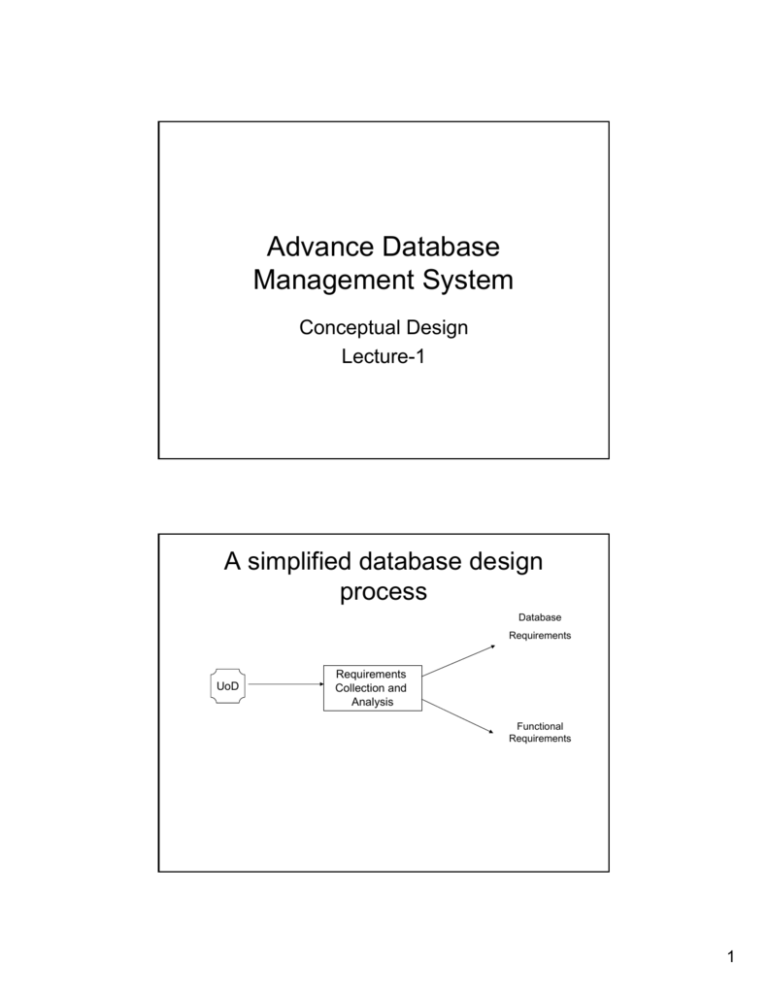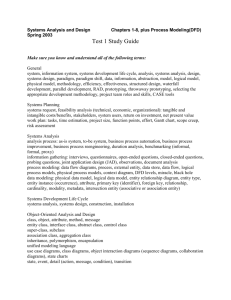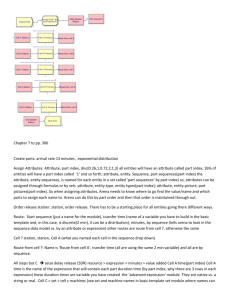View File
advertisement

Advance Database Management System Conceptual Design Lecture-1 A simplified database design process Database Requirements UoD Requirements Collection and Analysis Functional Requirements 1 A simplified database design process Database Requirements Conceptual Design Functional Requirements Functional Analysis Conceptual Schema High-level Transaction Spec. DBMS Independent Conceptual Schema Physical Design Internal Schema Application software Hign-level Transaction Specs Application Program Design Transaction Implementation DBMS Dependent 2 Conceptual Schema • Outcome of high-level conceptual design • Concise description of data requirements of the users • Include description of Entity types, relationship and constraints • No implementation details • Ease of Understanding, used to communicate with non-technical users Example COMPANY Database • Department: Name, Dept-ID, Manager, … • Project: Name, Proj-ID, Location (Managed by Departments) • Employee: name, PAN, Address, Salary, Gender, DOB … • Dependents: Name, Address, Gender, DOB, Relationship with Employee 3 Entities and Attributes Dept_Name Dept_ID Manager Department • An entity represents an object of the real world that has an independent existence • An entity has attributes – properties that describe it Attribute types • Simple Vs Composite – A composite attribute is made of one or more single or composite attributes. Example: Name is made of First Name, Middle Name and Last Name • Single-valued Vs Multi-valued – A single-valued attribute is described by one value (Example: age of a person) – A multi-valued attribute is described by many values (Example: the color attribute of multi-colored bird) 4 Attribute types • Stored Vs Derived – An attribute whose value can be inferred from the values of other attributes is called derived attribute (Example: age can be derived from Date of Birth and current date). If this is not the case then it’s a stored attribute. • Null Values – Attributes that do not have any applicable values are said to have null values. Different from 0, unknown and missing values Entity types and Entity sets • An Entity type defines a collection of different entities having the same type. – For example “Department” defined earlier is an entity type defining several department having the same attribute structure • Any specific collection of entities of a particular type is called an entity set. • An Entity Type describes the Schema or intention for an Entity Set 5 Representations Attributes Entity Types Derived Attributes Multi-valued Attributes Key Attributes Dept_Name Dept_ID Manager Department • The Dept_ID is unique for each department belonging to this entity set. • Dept_ID can hence uniquely identify departments. 6 Key Attributes • An attribute or a set of attribute that uniquely identify entities in an entity set are called key attribute(s). • When a collection of attributes define a key, the set is called composite key. • Composite key should be minimal, no subset of composite key should be key itself. • Key attributes are shown underlined in ER diagram Key Attributes • Key attributes should retain the unique definition property for all extensions (EER Model) of the entity type. • An entity type may have more than one keys independent of each other. (Example: Two Ethernet defining the same machine) • Some entity type may have no key attributes, Entities of such types are called weak entities 7 Domain of Attributes • The domain of an attribute is the set of all valid values that an attribute can attain. – Example: The domain of an attribute “Age” of an employee is the set of all integers between 18 to 65. • If composite attribute have n values with domains D1, D2, …, Dn. Then the domain of an attribute is D1 x D2 x …x Dn. The COMPANY Revisited Entity Types Attributes Department Dept_id, Name, No. of Employees, Manager,… Project Proj_id, Name, Team Strength, Locations, ControllingDept,… Emp_id, Name(F,M,L), PAN, Gender, Address, Salary, … Employee 8 Relationships Department Managed_by Employee • Relationship type relates two or more entity type and define a relationship set. Any given depiction of a relationship type is called a relationship instance. Relationships • A relationship type R among n entity types E1, E2, … En, defines a set of associations (a relationship set) among entities of this type. 9 Relationships • Degree of a relationship type. The number of participating entity types in this relationship type – Ex: Degree of relationship Department “managed_by” Employee is 2 • Unary, Binary and Ternary relationships are the special terms used for relationship of degree 1, 2 and 3 respectively – Quick Exercise: Think of a example for a unary relationship in COMPANY example Relationships Vs Attributes Employee Works for Department Department Employee 10 Relationships Vs Attributes Dept-ID Employee Works for Department Dept-ID Employee Relationships Vs Attributes • Relationships as attributes are a concept used in data models called functional data models • In object databases relationships are represented by object references • In relational databases foreign keys represents relationships as attributes 11 Constraints on Relationship Types • Constraints limit the set of possible combination of entities that can participate in the relationship type • Two main kind of constraints: – Cardinality Ratio – Participation Constraints Cardinality Ratios (N:1) Employee N Works for 1 Department • Represents a cardinality constraint that while a department may have any number (N) of employees, each employee entity should be associated with only one department instance. • Quick Exercise: How would you interpret it if in the above relationship the ratio were to be (M:N) instead of (N:1) 12 Participation Constraints Department 1 Handles N Project • If every project has to be associated with a department, then the “existence” of an instance of Project entity type depends on the existence of instance of the Handles relationship type. Participation Constraints Department 1 Handles N Project • The entity type Project is said to be “totally participate” in relationship type Handles. The relationship is also said to introduce an existence dependency on “Project”. • Total participation is shown with the double line in the ER diagram 13 Attributes of Relationship Types Budget Department M Handles N Project • Budget refers to the allocated budget for a specific department for handling a specific budget. It belongs neither to the Department nor to the Project for its entirety. Attributes of Relationship Types Budget Department 1 Handles N • In 1:N or 1:1 relationships, relationship attributes can be moved to a corresponding participating entity type Department 1 Handles Project Budget N Project 14 Identifying Relationships PAN Employee 1 Insurance Details 1 Insurance Record • Insurance Record is a “weak entity type” with no key. It has no existence without its association with entity type Employee. • The relationship Insurance Details is an “Identifying relationship”. • Note the convention for representing weak entity types and identifying relationships Identifying Relationships PAN Employee 1 Insurance Details 1 Insurance Record • Weak entity types always totally participate in their identifying relationships, however not all total participation indicate weak entity types • Quick Exercise: Think of an example of total participation from an entity type which is not a weak entity type in a relationship 15 Summary of ER Notations Employee Insurance Record Handles Insurance Details Entity Type Weak Entity Type Relationship Type Identifying Relationship Type Summary of ER Notations Attribute PAN Key Attribute Multi-valued Attribute Derived Attribute 16





